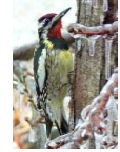
The next question becomes when is the best time to plant citrus trees? Because of the susceptibility of citrus to cold or freezing temperatures it is common to wait until the month of February to plant citrus trees. The idea is that trees planted in February are less likely to be exposed to hard freezes that could severely damage or kill trees. An appealing aspect of citrus production is that once the fruit are mature they can be left on the tree and picked as needed unless there is an extended hard freeze prompting removal of the fruit from the trees.
Surprisingly I’ve gotten eight to ten calls from people that still have satsumas or sweet oranges on their trees and are asking is there any problem with leaving the fruit on the tree. I rarely recommend leaving satsumas or sweet oranges on trees past the month of January. Experienced citrus growers says that leaving fruit on the trees into February and beyond negatively impacts the next crop of fruit because it causes decreases in bloom, which translates into decreases in fruit. Needless to say, for those people who still have not picked fruit off of their trees, they need to pick them as soon as possible so as not to impact the next crop of fruit. Another factor is the warmer the temperatures become the more the quality of the fruit left on the tree may be diminished.
As I ride around Lafayette Parish on some of my home visits to assess or evaluate landscape problems I’m noticing more improper pruning of crape myrtles. It is not uncommon for some gardeners or landscape maintenance professionals to severely lower the height of crape myrtle by pruning with pruning saws or even chain saws, thus the saying “Crape Murder!” Pruning of crape myrtle should primarily consist of removing any crossing or rubbing branches which should be removed at its point of origin. Any small growth such as suckers that sprout at the base of the trunk or water sprouts that come up on branches, should be removed with hand pruners or loppers. Anytime I see gardeners using a chain saw to prune crape myrtles it tells me that they’re probably going to employ some improper pruning techniques. As Master Gardeners you’ll need to not be shy about giving advice regarding proper pruning of crape myrtles. Improper pruning definitely destroys the natural character that makes crape myrtles so beautiful in south Louisiana landscapes.
If you’ve ever noticed small pencil size holes neatly arranged in the bark of primarily oak trees but also occasionally on pecan trees, this is caused by a small bird called the yellow bellied sapsucker, a woodpecker that drills holes in the bark of trees. These holes penetrate the bark causing sugary sap to ooze which the sapsucker comes back to feed on, along with any insects that the sap may have attracted. The damage usually doesn’t threaten the tree and no control is recommended or necessary; however, since it is unsightly many gardeners call out of concern for the tree or because they would like to know what caused the holes.
When buying pesticides be sure that you know what pest you’re trying to control so that you get the correct pesticide. If it’s a fungus disease then you need a fungicide!! If it’s an insect then you need an insecticide!! If it’s a rodent then you need a rodenticide!! Never buy a container of a pesticide larger than you can use within a year or two. I usually tell people that it’s highly possible depending on how it is stored that pesticides older than three years old may have lost most of its effectiveness. Most importantly read all label directions in terms of how to mix and apply. Remember the label is the law and it’s there not only for your safety but the safety of others and the environment!!
As spring approaches and day and night time temperatures begin to moderate the temptation to fertilize our lawns begins to intensify. However, keep in mind that our lawns are warm season grasses, and until the soil warms its root system, much of the grass won’t be very active in absorbing nutrients. If lawns are fertilized too early, winter weeds that thrive in cool soils will absorb much of the fertilizer meant for the lawn. That is the problem with applying weed and feeds too early. Remember weed and feed materials are a combination of a fertilizer and a herbicide in the same bag. While it is okay to control weeds in late winter and early spring, it’s too early to apply fertilizer. The first application of fertilizer should be no earlier than the first or second week in April here in South Louisiana. Another factor is that as long as we’re having cool night time temperatures in late winter and early spring, the pathogen that causes brown patch disease in lawns is active (especially in St Augustine lawns) and can become very aggressive, especially if we experience a rainy spring. Fertilizing too early will aggravate or stimulate brown patch activity because of the nitrogen in fertilizer.
HAPPY GARDENING!
GeraldP.Roberts
Horticulturist/Master Gardener Program Coordinator
LSU AgCenter 1010 Lafayette Street, Suite 325, Lafayette, LA 70501 [email protected], Office (337) 291-7090 /Fax (337) 291-7099


 RSS Feed
RSS Feed